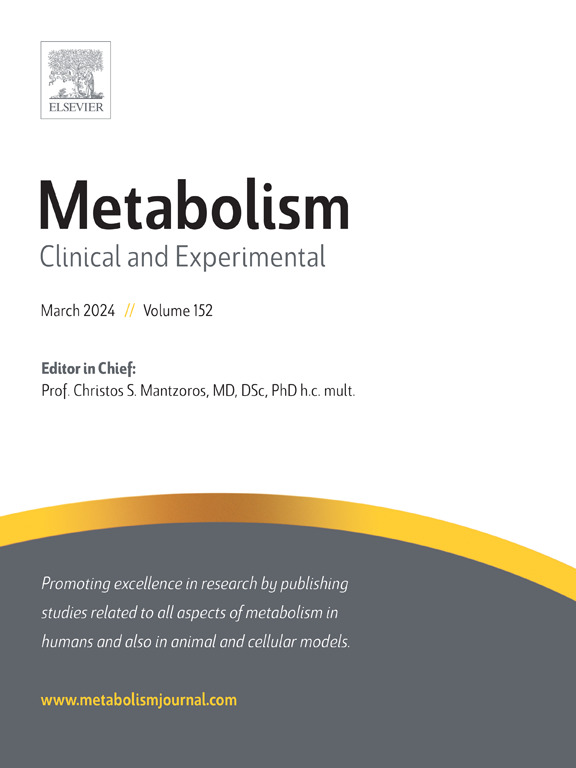Prevalence, characteristics and outcomes of patients with metabolic and alcohol related/associated liver disease (MetALD): a systematic review and meta-analysis
IF 10.8
1区 医学
Q1 ENDOCRINOLOGY & METABOLISM
引用次数: 0
Abstract
Background
In light of the new nomenclature of steatotic liver disease (SLD), we aimed to enhance the existing knowledge on the epidemiology and clinical outcomes of metabolic and alcohol related/associated liver disease (MetALD).
Methods
A systematic review and meta-analysis were performed in Medline/PubMed, Embase, Scopus and Cochrane databases to evaluate the prevalence and outcomes of MetALD within the SLD population and to compare the characteristics between MetALD patients and those with metabolic dysfunction associated steatotic liver disease (MASLD) and alcohol-related liver disease (ALD). Nineteen studies from nine countries that evaluated 4,543,341 adult participants with SLD were included.
Results
The pooled overall prevalence of MetALD among the SLD population was 10 % (95%CI:7–13 %) without significant difference between Asian and non-Asian populations. However, MetALD was more frequent in men than women (86 % vs 14 %, p < 0.01), while Asian MetALD patients, were more frequent men (92 % vs 66 %, p < 0.01) compared to non-Asians. Additionally, in terms of metabolic characteristics there were no significant differences between MetALD, MASLD and ALD patients. Regarding outcomes, patients with MetALD, compared to non-SLD, were at increased risk of all-cause [HR 1.44 (95%CI:1.24–1.66)], cardiovascular disease (CVD) [HR 1.17 (95%CI:1.12–1.21)] and cancer-related mortality [HR 2.07 (95%CI:1.32–3.25)]. Finally, patients with MetALD, had increased incidence of CVD and liver decompensating events, compared to non-SLD participants [HR 1.49 (95%CI:1.03–2.15); HR 10.55 (95%CI:3.46–32.16) respectively].
Conclusions
Based on the existing literature, patients with MetALD consist a significant part of the SLD population, with high all-cause, CVD and cancer-related mortality and increased risk for CVD and hepatic decompensation.

代谢性和酒精相关/相关肝病患者的患病率、特征和结局:一项系统综述和荟萃分析
背景:鉴于脂肪变性肝病(SLD)的新命名,我们旨在加强对代谢和酒精相关/相关肝病(MetALD)的流行病学和临床结果的现有知识。方法:在Medline/PubMed、Embase、Scopus和Cochrane数据库中进行系统回顾和荟萃分析,以评估SLD人群中MetALD的患病率和结局,并比较MetALD患者与代谢功能障碍相关脂肪变性肝病(MASLD)和酒精相关性肝病(ALD)患者的特征。来自9个国家的19项研究评估了4,543,341名患有SLD的成人参与者。结果:在SLD人群中,MetALD的总患病率为10 % (95%CI:7-13 %),亚洲和非亚洲人群之间无显著差异。然而,MetALD在男性中的发生率高于女性(86% % vs 14% %,p )。结论:根据现有文献,MetALD患者在SLD人群中占很大一部分,其全因、心血管疾病和癌症相关死亡率高,心血管疾病和肝脏失代偿的风险增加。
本文章由计算机程序翻译,如有差异,请以英文原文为准。
求助全文
约1分钟内获得全文
求助全文
来源期刊

Metabolism: clinical and experimental
医学-内分泌学与代谢
CiteScore
18.90
自引率
3.10%
发文量
310
审稿时长
16 days
期刊介绍:
Metabolism upholds research excellence by disseminating high-quality original research, reviews, editorials, and commentaries covering all facets of human metabolism.
Consideration for publication in Metabolism extends to studies in humans, animal, and cellular models, with a particular emphasis on work demonstrating strong translational potential.
The journal addresses a range of topics, including:
- Energy Expenditure and Obesity
- Metabolic Syndrome, Prediabetes, and Diabetes
- Nutrition, Exercise, and the Environment
- Genetics and Genomics, Proteomics, and Metabolomics
- Carbohydrate, Lipid, and Protein Metabolism
- Endocrinology and Hypertension
- Mineral and Bone Metabolism
- Cardiovascular Diseases and Malignancies
- Inflammation in metabolism and immunometabolism
 求助内容:
求助内容: 应助结果提醒方式:
应助结果提醒方式:


